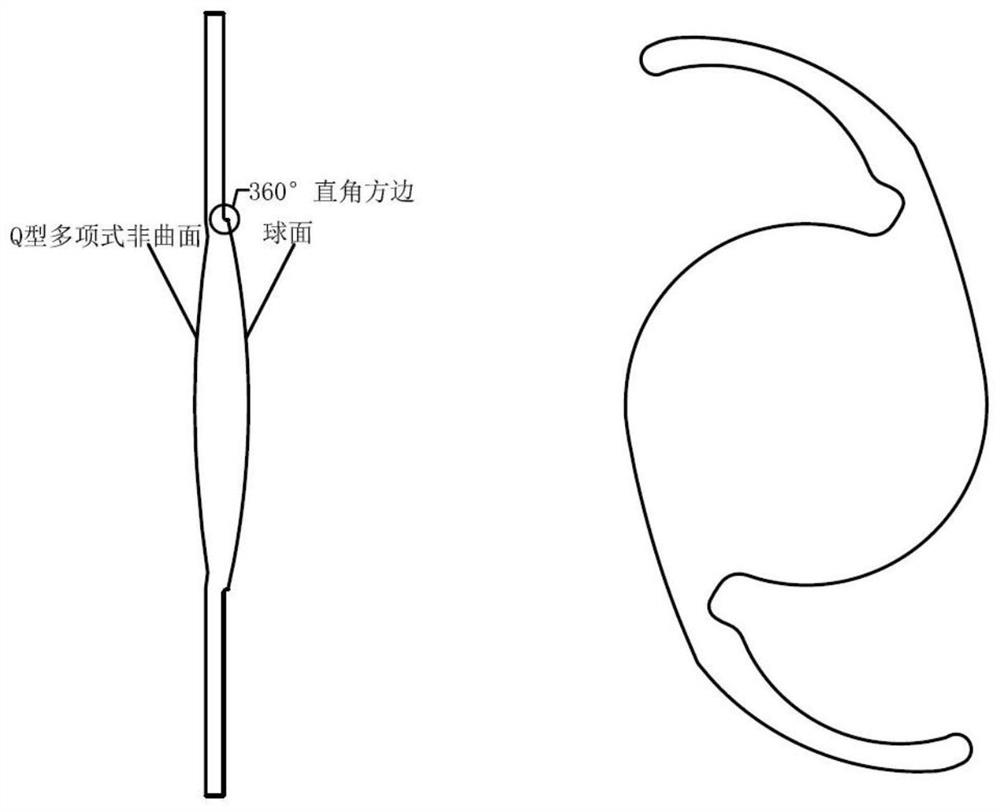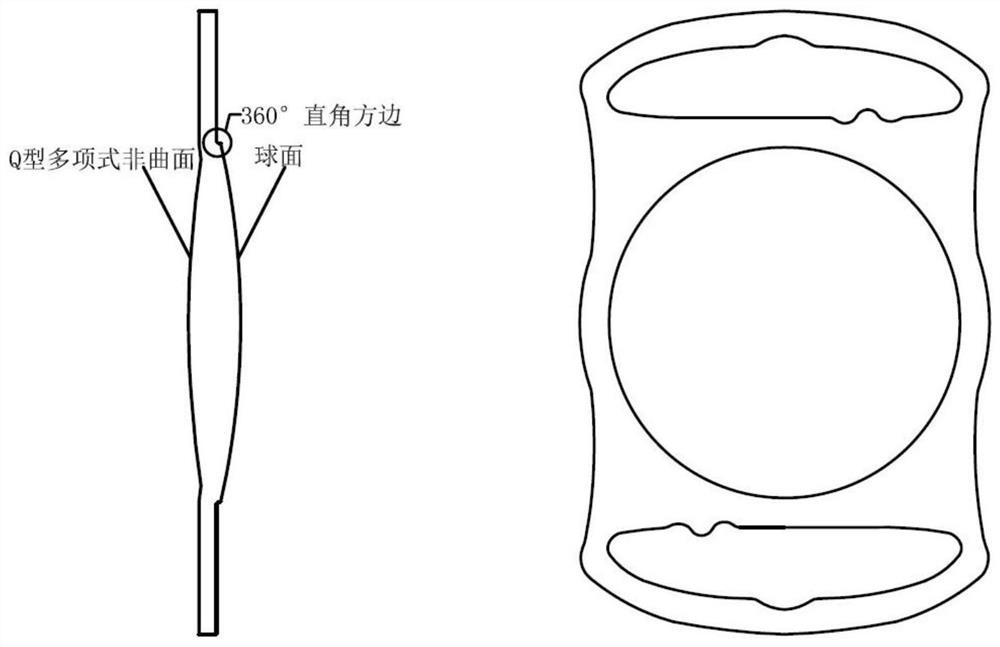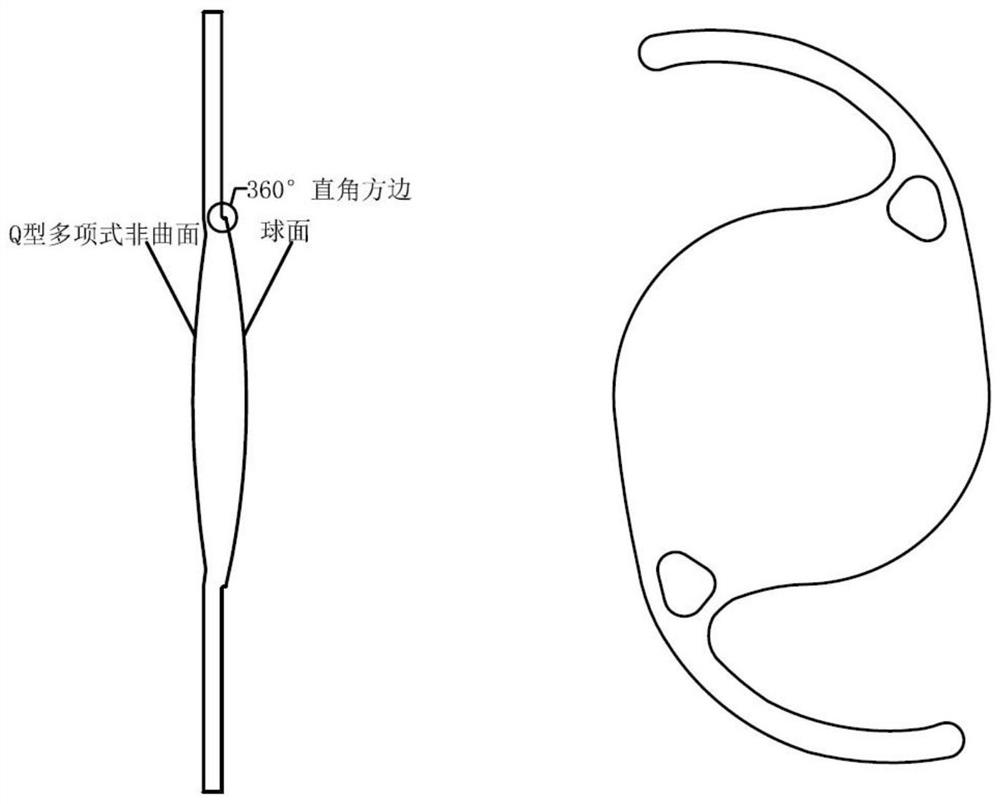Aspheric artificial lens for resisting postoperative residual refractive error
A technology for intraocular lens and refractive error, applied in the fields of intraocular lens, prosthesis, medical science, etc., can solve the problem that the modulation of spherical aberration is difficult to play its role, so as to resist residual refractive error, reduce sensitivity, and improve surgical performance. The effect of fault tolerance
- Summary
- Abstract
- Description
- Claims
- Application Information
AI Technical Summary
Problems solved by technology
Method used
Image
Examples
Embodiment 1
[0075] like figure 1 As shown, an aspheric intraocular lens for resisting postoperative residual ametropia, the intraocular lens includes an optical main body (1), a first supporting haptic (2) and a second supporting haptic (3), and the optical main body (1 ) adopts the aspheric design characterized by Q-type polynomials to broaden the range of the defocus curve under the premise of ensuring a certain total area, and to combat residual refractive errors after surgery.
[0076] The optical main body (1), the first supporting haptic (2) and the second supporting haptic (3) are of an integrated structure, and are integrally formed by using the same material.
[0077] The periphery of the optical main body (1) has 360° right-angled square sides, which can effectively suppress the occurrence of post-cataract.
[0078] The optical body (1) is composed of two optical surfaces, which can be spherical or aspherical, at least one of which is designed with an aspheric surface character...
Embodiment 2
[0109] like figure 2 As shown, an aspheric intraocular lens for resisting postoperative residual ametropia, the intraocular lens includes an optical main body (1), a first supporting haptic (2) and a second supporting haptic (3), and the optical main body (1 ) against postoperative residual refractive error.
[0110] The optical main body (1), the first supporting haptic (2) and the second supporting haptic (3) are of an integrated structure, and are integrally formed by using the same material.
[0111] The periphery of the optical main body (1) has 360° right-angled square sides, which can effectively suppress the occurrence of post-cataract.
[0112] The optical body (1) is composed of two optical surfaces, which can be spherical or aspherical, at least one of which is designed with an aspheric surface characterized by a Q-type polynomial, specifically it can be "strong aspheric Q con ” or “Moderate Aspherical Q bfs ".
[0113] The diameter of the effective optical zon...
Embodiment 3
[0143] like image 3 As shown, an aspheric intraocular lens for resisting postoperative residual ametropia, the intraocular lens includes an optical main body (1), a first supporting haptic (2) and a second supporting haptic (3), and the optical main body (1 ) against postoperative residual refractive error.
[0144] The optical main body (1), the first supporting haptic (2) and the second supporting haptic (3) are of an integrated structure, and are integrally formed by using the same material.
[0145] The periphery of the optical main body (1) has 360° right-angled square sides, which can effectively suppress the occurrence of post-cataract.
[0146] The optical body (1) is composed of two optical surfaces, which can be spherical or aspherical, at least one of which is designed with an aspheric surface characterized by a Q-type polynomial, specifically it can be "strong aspheric Q con ” or “Moderate Aspherical Q bfs ".
[0147] The diameter of the effective optical zone...
PUM
 Login to View More
Login to View More Abstract
Description
Claims
Application Information
 Login to View More
Login to View More - R&D
- Intellectual Property
- Life Sciences
- Materials
- Tech Scout
- Unparalleled Data Quality
- Higher Quality Content
- 60% Fewer Hallucinations
Browse by: Latest US Patents, China's latest patents, Technical Efficacy Thesaurus, Application Domain, Technology Topic, Popular Technical Reports.
© 2025 PatSnap. All rights reserved.Legal|Privacy policy|Modern Slavery Act Transparency Statement|Sitemap|About US| Contact US: help@patsnap.com



